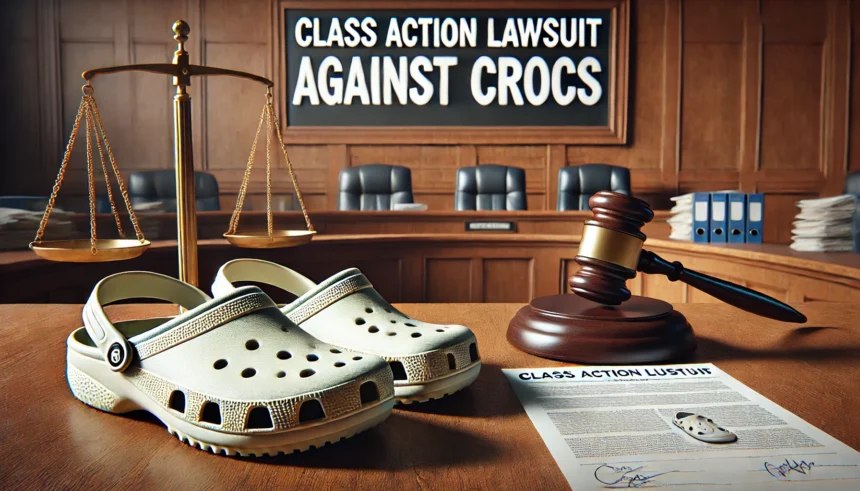The class action lawsuit Crocs is currently attracting widespread attention. This legal action involves numerous consumers who have raised concerns about the company’s products and business practices.
Central to the class action lawsuit Crocs is the allegation that the company may have misled customers regarding the quality and safety of its footwear. Plaintiffs are seeking compensation for what they claim are defective products.
As the case progresses, the class action lawsuit Crocs could have significant implications for the company’s reputation and financial standing. Legal experts are closely monitoring the developments to understand the potential outcomes.
The class action lawsuit Crocs also highlights broader issues within the footwear industry, particularly regarding consumer protection and product transparency. Depending on the court’s decision, other companies may face similar legal challenges.
Ultimately, the class action lawsuit Crocs serves as a critical test of the company’s commitment to addressing customer grievances and maintaining industry standards. The resolution of this lawsuit could set important precedents for future consumer-related legal actions.
Background on Crocs and Its Legal Challenges
Crocs was established in 2002 and quickly became known for its distinctive foam clogs. The brand gained popularity for its comfort and unique design, attracting a diverse customer base worldwide.
Over the years, Crocs expanded its product line to include various styles, catering to different fashion preferences. This growth helped the company achieve significant market presence and brand recognition.
However, alongside its success, Crocs has faced several legal challenges. These include trademark disputes and consumer complaints about product quality. The most recent issue is the class action lawsuit that has garnered widespread attention.
These legal challenges have prompted Crocs to enhance its compliance measures and improve transparency in its operations. Understanding Crocs’ legal history provides context for the current lawsuit and its potential impact on the company.
What Led to the Class Action Lawsuit Crocs Is Involved In?
The class action lawsuit against Crocs originated from numerous consumer complaints regarding product defects and misleading marketing practices. Customers reported issues such as uncomfortable footwear and premature wear and tear.
One major factor was the perception that Crocs’ marketing exaggerated the durability and comfort of their products. Consumers felt that the actual performance did not match the advertised claims, leading to dissatisfaction.
Additionally, there were allegations of hidden fees and deceptive pricing strategies. Consumers accused Crocs of not clearly disclosing all costs associated with their purchases, including shipping and handling fees.
Social media and online reviews played a crucial role in highlighting these issues. Negative feedback and viral posts amplified consumer grievances, prompting affected individuals to seek collective legal action through a class action lawsuit.
Key Legal Allegations in the Class Action Lawsuit Crocs
The class action lawsuit against Crocs includes several key legal allegations. Firstly, plaintiffs claim that Crocs engaged in false advertising by overstating the durability and comfort of their footwear.
Another major allegation involves product defects. Consumers assert that certain Crocs products are prone to breaking and do not meet safety standards, posing risks to users’ health and safety.
Additionally, there are claims of deceptive pricing practices. Plaintiffs argue that Crocs failed to fully disclose all costs, leading consumers to pay more than they initially expected.
Lastly, the lawsuit addresses inadequate customer service. Plaintiffs allege that Crocs did not effectively address their complaints or provide satisfactory remedies for defective products.
How the Class Action Lawsuit Could Impact Crocs’ Business
The class action lawsuit could have significant implications for Crocs’ business operations and reputation. If the court rules against Crocs, the company may face substantial financial penalties and compensation payouts to affected consumers.
Negative publicity from the lawsuit can damage Crocs’ brand image, leading to a decline in consumer trust and sales. Potential customers might be deterred from purchasing Crocs products due to the ongoing legal issues.
Moreover, the lawsuit may result in increased regulatory scrutiny. Crocs might be required to implement stricter compliance measures, which could lead to higher operational costs and changes in business practices.
Investor confidence could also be affected. Legal challenges and potential financial losses may cause fluctuations in Crocs’ stock price, impacting the company’s market valuation and ability to attract future investments.
Timeline of Events Leading to the Class Action Lawsuit
Early 2023: Consumers begin reporting issues with Crocs products on social media and review platforms. Complaints focus on product defects and misleading marketing claims.
Mid-2023: Consumer advocacy groups take notice of the increasing number of complaints. They start organizing affected individuals to address their grievances collectively.
Late 2023: A formal class action lawsuit is filed against Crocs, citing multiple instances of defective products and deceptive business practices. Legal proceedings commence.
Early 2024: The court schedules initial hearings and begins the discovery process. Both plaintiffs and Crocs present their evidence and arguments.
Mid-2024: Preliminary rulings are issued, and negotiations for a possible settlement begin. The lawsuit continues to gain media attention, keeping public interest high.
Consumer Reactions to the Class Action Lawsuit Crocs
Consumers have reacted strongly to the class action lawsuit against Crocs. Many affected customers express frustration and disappointment, feeling that their concerns were not adequately addressed by the company.
On social media, consumers share their negative experiences, creating a unified voice that supports the lawsuit. Hashtags related to the lawsuit trend, amplifying the collective demand for accountability and compensation.
Some loyal customers remain hopeful that Crocs will resolve the issues effectively. They believe that the company can address the defects and improve its customer service, restoring their trust in the brand.
Overall, the lawsuit has heightened awareness about consumer rights and the importance of transparent business practices. It has also encouraged other dissatisfied customers to come forward and join the legal action.
Potential Outcomes of the Class Action Lawsuit
The class action lawsuit against Crocs could result in several potential outcomes:
- Settlement Agreement: Crocs may agree to compensate the plaintiffs without admitting wrongdoing. This would resolve the lawsuit without a court ruling.
- Court Ruling in Favor of Plaintiffs: If the court finds Crocs liable, the company may be required to pay significant damages and implement corrective measures.
- Dismissal of the Lawsuit: Crocs could successfully defend itself, leading to the dismissal of the case and restoration of its reputation.
- Partial Victory: The court might rule in favor of some claims while dismissing others, resulting in a mixed outcome for both parties.
Each outcome will have distinct implications for Crocs’ financial health and reputation, as well as for the broader footwear industry.
Legal Implications for Footwear Companies Following the Crocs Lawsuit
The Crocs lawsuit sets important precedents for the footwear industry. One major implication is the increased emphasis on product quality and safety standards. Companies may need to enhance their quality control processes to avoid similar legal challenges.
Another implication involves marketing practices. Footwear companies will need to ensure that their advertising is truthful and not misleading, avoiding exaggerated claims about product performance and durability.
The lawsuit also highlights the importance of transparent pricing strategies. Companies may be required to clearly disclose all costs associated with their products, including any additional fees, to prevent consumer deception.
Furthermore, the case underscores the need for effective customer service. Footwear companies might invest more in their support systems to address consumer complaints promptly and satisfactorily, reducing the risk of legal actions.
Crocs’ Defense Strategy in the Class Action Lawsuit
Crocs has developed a comprehensive defense strategy to address the allegations in the class action lawsuit. The company asserts that its marketing practices are truthful and that the products meet all safety and quality standards.
Crocs is likely presenting evidence of rigorous quality control measures and compliance with industry regulations. This includes documentation of product testing and safety certifications to counter claims of defects.
Additionally, Crocs may argue that the plaintiffs’ claims are isolated incidents rather than indicative of systemic issues. By highlighting the overall positive customer feedback and low defect rates, the company aims to demonstrate that the lawsuit is unfounded.
Negotiation for a settlement is also part of Crocs’ strategy. Offering compensation or product replacements to affected consumers could help resolve the lawsuit amicably and mitigate reputational damage.
Lessons for Businesses from the Class Action Lawsuit Against Crocs
The class action lawsuit against Crocs offers several valuable lessons for businesses:
- Transparency is Crucial: Clear and honest communication about product features and pricing can prevent misunderstandings and build consumer trust.
- Quality Control Matters: Implementing stringent quality assurance processes ensures that products meet safety and performance standards, reducing the risk of defects and consumer dissatisfaction.
- Effective Customer Service: Promptly addressing customer complaints and providing adequate remedies can enhance customer loyalty and prevent legal actions.
- Legal Compliance: Staying informed about relevant laws and regulations helps businesses avoid legal pitfalls and maintain ethical standards.
- Proactive Risk Management: Identifying and mitigating potential risks in business operations can prevent issues from escalating into significant problems.
By learning from Crocs’ challenges, businesses can adopt strategies that promote transparency, quality, and customer satisfaction, thereby minimizing the likelihood of facing similar legal challenges.
Final Thoughts on the Class Action Lawsuit Crocs Is Facing
The class action lawsuit against Crocs is a pivotal moment for the company and the footwear industry. It highlights the importance of maintaining high standards in product quality, marketing honesty, and customer service.
The outcome of the lawsuit will have significant implications for Crocs’ reputation and financial stability. A favorable resolution could restore consumer trust, while an unfavorable one might lead to substantial financial penalties and long-term damage to the brand.
For the broader industry, the lawsuit serves as a reminder of the critical need for transparency and accountability. Footwear companies will need to prioritize these aspects to avoid similar legal challenges and maintain consumer confidence.
Ultimately, the Crocs lawsuit underscores the power of collective consumer action in holding companies accountable. It emphasizes the importance of ethical business practices and the need for businesses to continuously strive for excellence in all aspects of their operations.
As the case progresses, stakeholders will be closely watching the developments, recognizing that the resolution will set important precedents for future consumer-related legal actions and industry standards.












